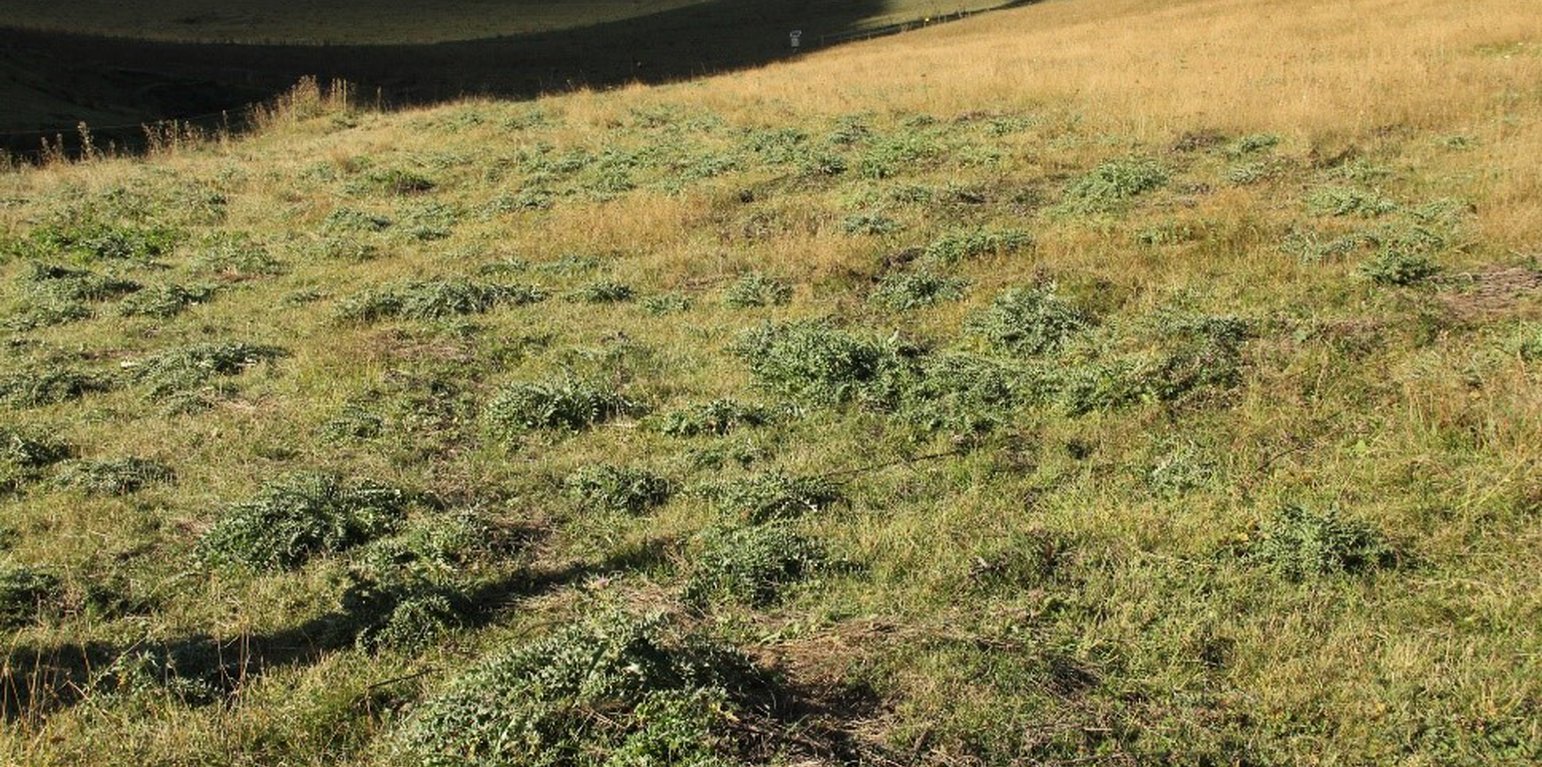Pasture-weed control by thistle cutting
(Georgia)
Description
Thistles invaded massively into village pasture land at 1800m elevation in the Caucasus. By cutting the thistles with a motor-cutter the cover of thistles have been reduced.
The technology was applied in flat sub-alpine pasture land at an elevation of about 1800 m in the village of Shenako in the Tusheti Protected Landscape, Georgia. Precipitation is 750-900mm and mean annual temperature is 2-4°C. Thistles (Cirsium sp.) were invading especially in those sections of the pasture that are rich in nutrients and have medium soil water content. This site conditions can be found mainly at the valley bottom.
There are no big machines available in this mountain villages. So the removal was done by motor-cutters. In this particular case STIHL petrol brush cutters were used with a 3 blade bush knife.
The removal of the thistles, which were covering up to 20% of the pasture land will increase the productivity of valuable fodder grass and herbs. The thistles are growing up to 1m height and taking up significant amount of nutrients from the soil and are shading other grass and herbs in their neighborhood. Because of their spices they are not eaten by cows or sheep, while the grazing pressure is increasing on the remaining grass and herb species. This leads to positive selection of thistles and a permanent increase of the thistles number and biomass in comparison to the high quality fodder plants.
The thistles have been cut in mid-June/beginning of July just at the begin of blossom. At this stage, the thistles mobilized most of the nutrients from their root system and spent them in leaf and blossom biomass. By cutting the thistles at this time, the highest impact on the nutrient balance can be reached and no new seeds will be produced in this year. It was observed, that the thistles have been eaten by the livestock when it was cut and dried up.
The motor brush cutter increases significantly the speed of cutting the thistles compared to hand scythe. The thistle has a powerful root system and is re-sprouting from the roots within the same summer. So it is important to repeat the cutting 2-3 times a year and to continue several years until the amount of thistles is permanently reduced.
The reduction of thistles will give more space, nutrients and moisture to other fodder plants and increase the productivity of the pasture land.
The challenge is the coordination of the work load within the users of the community pasture land. It needs a (written) agreement to share the workload for pasture maintenance between the families according to their number of livestock.
Location
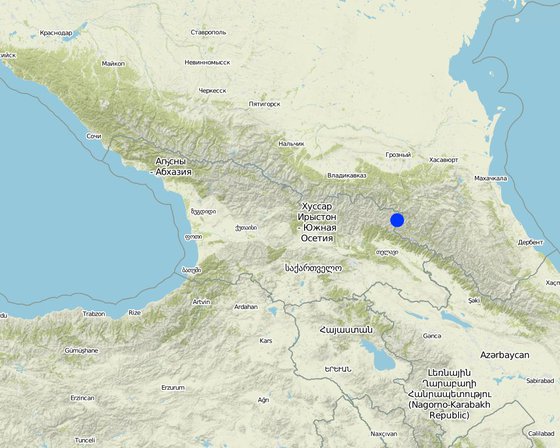
Location: Shenako, Kakheti, Georgia
No. of Technology sites analysed: 2-10 sites
Geo-reference of selected sites
Spread of the Technology: evenly spread over an area (0.02 km²)
In a permanently protected area?: Ja
Date of implementation: 2018
Type of introduction
-
through land users' innovation
-
as part of a traditional system (> 50 years)
-
during experiments/ research
-
through projects/ external interventions
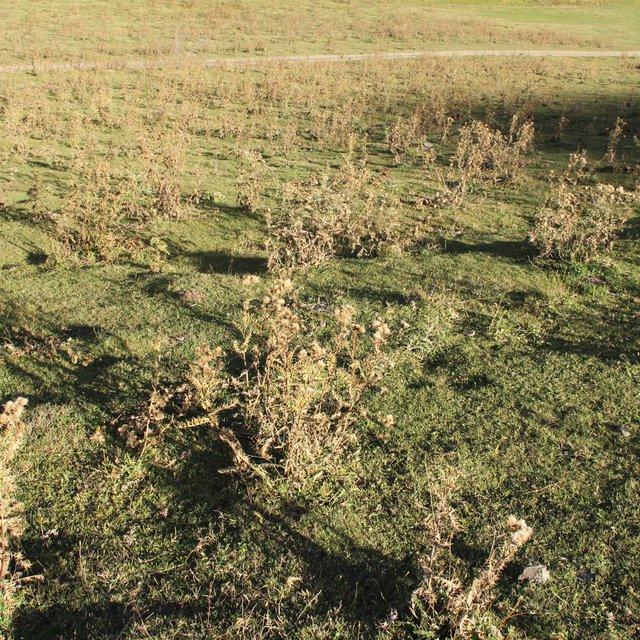
Dense population of thistle on pasture land (Hanns Kirchmeir)
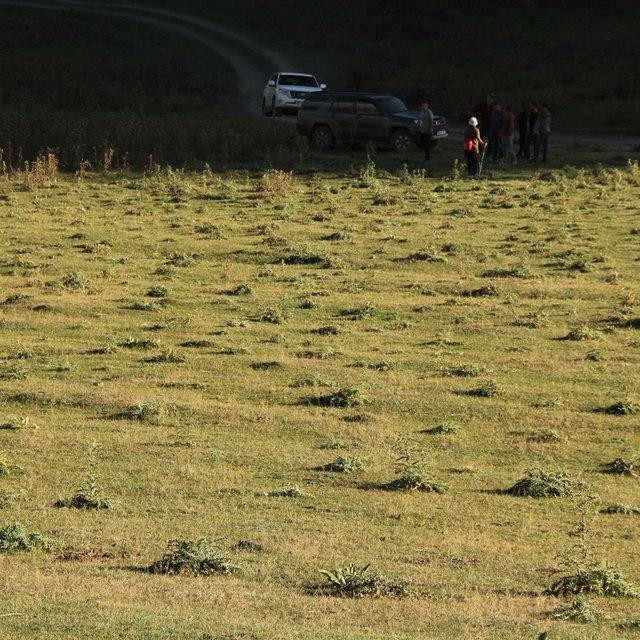
Thistles cut at begin of July (Hanns Kirchmeir)
Classification of the Technology
Main purpose
-
improve production
-
reduce, prevent, restore land degradation
-
conserve ecosystem
-
protect a watershed/ downstream areas – in combination with other Technologies
-
preserve/ improve biodiversity
-
reduce risk of disasters
-
adapt to climate change/ extremes and its impacts
-
mitigate climate change and its impacts
-
create beneficial economic impact
-
create beneficial social impact
Land use
Land use mixed within the same land unit: Nee
-
Grazing land
Animal type: cattle - dairy, horses, sheep
Is integrated crop-livestock management practiced? Nee
Products and services: meat, milk
| Species | Count |
| cattle - dairy | 70 |
| sheep | 400 |
| horses | 30 |
| cattle - non-dairy beef | 35 |
Water supply
-
rainfed
-
mixed rainfed-irrigated
-
full irrigation
Purpose related to land degradation
-
prevent land degradation
-
reduce land degradation
-
restore/ rehabilitate severely degraded land
-
adapt to land degradation
-
not applicable
Degradation addressed
-
biological degradation - Bs: quality and species composition/ diversity decline
SLM group
-
pastoralism and grazing land management
SLM measures
-
management measures - M5: Control/ change of species composition
Technical drawing
Technical specifications
The activity was applied on two plots. Plot 6 is 0.7 ha of size and located in the unfenced area. Plot 7 is 1.3 ha of size and located inside an electric fence. The hatched area (8) is indicating the fenced area.
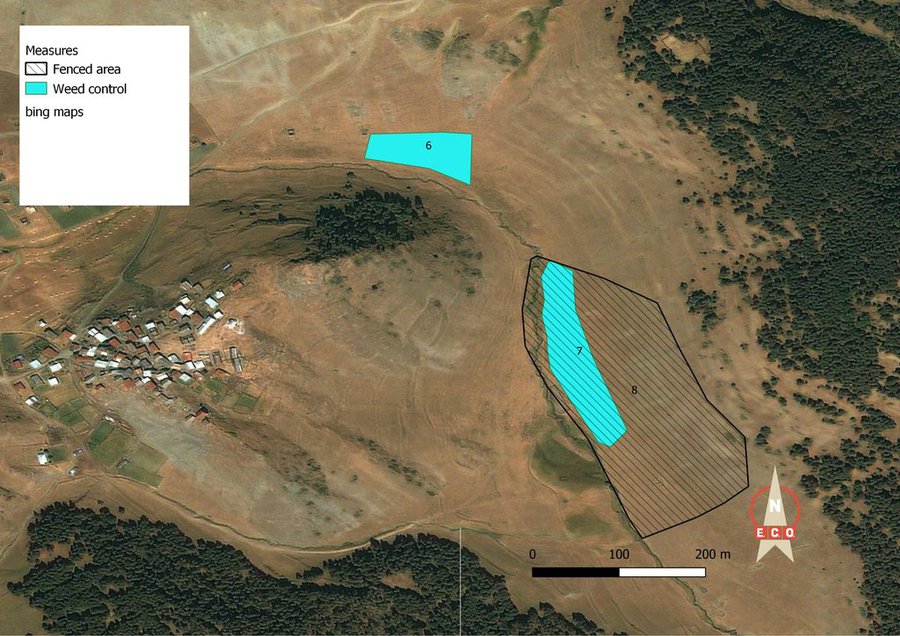
Author: Hanns Kirchmeir
Establishment and maintenance: activities, inputs and costs
Calculation of inputs and costs
- Costs are calculated: per Technology area (size and area unit: 2 ha)
- Currency used for cost calculation: USD
- Exchange rate (to USD): 1 USD = n.a
- Average wage cost of hired labour per day: n.a
Most important factors affecting the costs
The investment in the brush cutter will only pay off if large parts of pastures are managed.
Establishment activities
-
Prepare machinery and organize people (Timing/ frequency: June)
-
Select pasture plots were the measure will be applied (Timing/ frequency: June)
-
Cut the thistles on the selected pasture plots (Timing/ frequency: End of June - Mid of July)
Establishment inputs and costs (per 2 ha)
| Specify input |
Unit |
Quantity |
Costs per Unit (USD) |
Total costs per input (USD) |
% of costs borne by land users |
|
Labour
|
| Selection of sites, preparation of materials and people |
person-days |
3.0 |
37.0 |
111.0 |
|
| Labour for cutting thistles on 2 ha |
person-days |
10.0 |
20.0 |
200.0 |
|
|
Equipment
|
| High quality brush cutter |
pieces |
1.0 |
800.0 |
800.0 |
|
| Patrol (20l) and diesel (30l) for brush cutter (6 days, 8h/day, 1l/h) |
liter |
50.0 |
1.0 |
50.0 |
|
| Total costs for establishment of the Technology |
1'161.0 |
|
| Total costs for establishment of the Technology in USD |
1'161.0 |
|
Maintenance activities
-
Repeat cutting of thistles 2x per year (Timing/ frequency: June/July and September)
Maintenance inputs and costs (per 2 ha)
| Specify input |
Unit |
Quantity |
Costs per Unit (USD) |
Total costs per input (USD) |
% of costs borne by land users |
|
Labour
|
| labour for cutting thistles (2ha) |
person-days |
6.0 |
20.0 |
120.0 |
100.0 |
|
Equipment
|
| Patrol for brush cutter |
liter |
96.0 |
1.0 |
96.0 |
|
| Total costs for maintenance of the Technology |
216.0 |
|
| Total costs for maintenance of the Technology in USD |
216.0 |
|
Natural environment
Average annual rainfall
-
< 250 mm
-
251-500 mm
-
501-750 mm
-
751-1,000 mm
-
1,001-1,500 mm
-
1,501-2,000 mm
-
2,001-3,000 mm
-
3,001-4,000 mm
-
> 4,000 mm
Agro-climatic zone
-
humid
-
sub-humid
-
semi-arid
-
arid
Specifications on climate
Average annual rainfall in mm: 850.0
Main rainfall in spring and autumn, July and August is the dry season.
Name of the meteorological station: Data from CHELSA.ORG
Because of low annual temperature (2-4°C) the evapotranspiration is low and most of the year there is no water shortage. But in August and September drought can occur.
Slope
-
flat (0-2%)
-
gentle (3-5%)
-
moderate (6-10%)
-
rolling (11-15%)
-
hilly (16-30%)
-
steep (31-60%)
-
very steep (>60%)
Landforms
-
plateau/plains
-
ridges
-
mountain slopes
-
hill slopes
-
footslopes
-
valley floors
Altitude
-
0-100 m a.s.l.
-
101-500 m a.s.l.
-
501-1,000 m a.s.l.
-
1,001-1,500 m a.s.l.
-
1,501-2,000 m a.s.l.
-
2,001-2,500 m a.s.l.
-
2,501-3,000 m a.s.l.
-
3,001-4,000 m a.s.l.
-
> 4,000 m a.s.l.
Technology is applied in
-
convex situations
-
concave situations
-
not relevant
Soil depth
-
very shallow (0-20 cm)
-
shallow (21-50 cm)
-
moderately deep (51-80 cm)
-
deep (81-120 cm)
-
very deep (> 120 cm)
Soil texture (topsoil)
-
coarse/ light (sandy)
-
medium (loamy, silty)
-
fine/ heavy (clay)
Soil texture (> 20 cm below surface)
-
coarse/ light (sandy)
-
medium (loamy, silty)
-
fine/ heavy (clay)
Topsoil organic matter content
-
high (>3%)
-
medium (1-3%)
-
low (<1%)
Groundwater table
-
on surface
-
< 5 m
-
5-50 m
-
> 50 m
Availability of surface water
-
excess
-
good
-
medium
-
poor/ none
Water quality (untreated)
-
good drinking water
-
poor drinking water (treatment required)
-
for agricultural use only (irrigation)
-
unusable
Water quality refers to: both ground and surface water
Is salinity a problem?
Occurrence of flooding
Characteristics of land users applying the Technology
Market orientation
-
subsistence (self-supply)
-
mixed (subsistence/ commercial)
-
commercial/ market
Off-farm income
-
less than 10% of all income
-
10-50% of all income
-
> 50% of all income
Relative level of wealth
-
very poor
-
poor
-
average
-
rich
-
very rich
Level of mechanization
-
manual work
-
animal traction
-
mechanized/ motorized
Sedentary or nomadic
-
Sedentary
-
Semi-nomadic
-
Nomadic
Individuals or groups
-
individual/ household
-
groups/ community
-
cooperative
-
employee (company, government)
Age
-
children
-
youth
-
middle-aged
-
elderly
Area used per household
-
< 0.5 ha
-
0.5-1 ha
-
1-2 ha
-
2-5 ha
-
5-15 ha
-
15-50 ha
-
50-100 ha
-
100-500 ha
-
500-1,000 ha
-
1,000-10,000 ha
-
> 10,000 ha
Scale
-
small-scale
-
medium-scale
-
large-scale
Land ownership
-
state
-
company
-
communal/ village
-
group
-
individual, not titled
-
individual, titled
Land use rights
-
open access (unorganized)
-
communal (organized)
-
leased
-
individual
Water use rights
-
open access (unorganized)
-
communal (organized)
-
leased
-
individual
Access to services and infrastructure
employment (e.g. off-farm)
drinking water and sanitation
Comments
Most important of-farm income is tourism (guesthouses, crafts).
Impacts
Socio-economic impacts
fodder production
By reduction of thistles the space for other plant species has increased.
Cost-benefit analysis
Benefits compared with establishment costs
Short-term returns
very negative
very positive
Long-term returns
very negative
very positive
Benefits compared with maintenance costs
Short-term returns
very negative
very positive
Adoption and adaptation
Percentage of land users in the area who have adopted the Technology
-
single cases/ experimental
-
1-10%
-
11-50%
-
> 50%
Of all those who have adopted the Technology, how many have done so without receiving material incentives?
-
0-10%
-
11-50%
-
51-90%
-
91-100%
Has the Technology been modified recently to adapt to changing conditions?
To which changing conditions?
-
climatic change/ extremes
-
changing markets
-
labour availability (e.g. due to migration)
Conclusions and lessons learnt
Strengths: land user's view
-
Decreasing the cost for maintanace of cattle
-
Reducing the working hours
-
Improving the pastures via weed control
Strengths: compiler’s or other key resource person’s view
-
Easy to apply, no specific skills needed
-
Visible impact within a few years
Weaknesses/ disadvantages/ risks: land user's viewhow to overcome
-
Irresponsibility of some members of the community during the maintenance of el-fence
Weaknesses/ disadvantages/ risks: compiler’s or other key resource person’s viewhow to overcome
-
No responsibility within the community pasture land for maintenance of pasture land.
A new regulation on how to share the workload of pasture maintenance could be negotiated between villagers.
-
Machinery is expensive.
The investment will pay off when the measures are applied to the entire pasture land (100-200 ha).
References
Date of documentation: Des. 18, 2018
Last update: Aug. 7, 2019
Resource persons
-
Hanns Kirchmeir - SLM specialist
-
Kety Tsereteli - co-compiler
Full description in the WOCAT database
Documentation was faciliated by
Institution
- Regional Environmental Centre for the Caucasus (REC Caucasus) - Georgia
Project
- Applying Landscape and Sustainable Land Management (L-SLM) for mitigating land degradation and contributing to poverty reduction in rural area (L-SLM Project)
